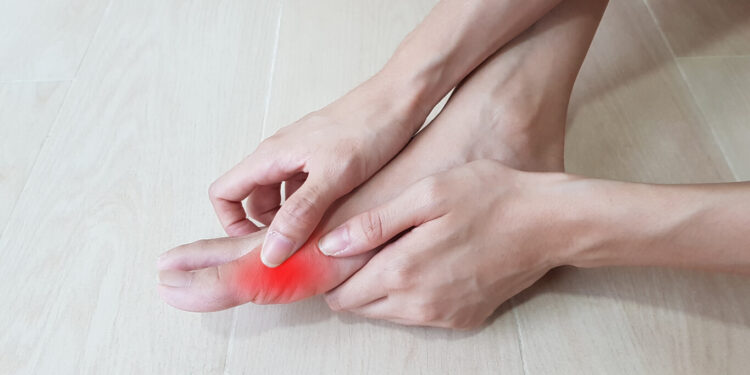Gout can be a severe and painful form of arthritis. It has been around since ancient times and is sometimes referred to as the “disease of kings.”
CUPERTINO, CALIFORNIA | NOW THEN DIGITAL — Gout is a painful condition that is caused by an excess of uric acid in the joints. This is a byproduct of the body’s metabolism of purines. These are found in certain foods, and excessive intake of such foods can increase your risk of developing gout.
- Gout is a painful condition that affects the joints. To treat it, you need to reduce your uric acid level. There are several types of medications that help to control uric acid in the body.
- These drugs include NSAIDs, colchicine, and corticosteroids. You may also need to change your lifestyle to prevent gout attacks. Dietary changes, exercise, and a reduced alcohol intake can all help you control gout and prevent future attacks.
- Acute attacks of arthritis can be severe and require medical attention. In severe cases, the condition can spread to other joints. The main symptoms of gout include intense swelling of one joint. Most people suffer from attacks in the big toe, but gout can also strike other joints, including the ankles and knees.
- Depending on the type of gout you have, your doctor may recommend a different treatment plan. For chronic gout, you’ll likely need to take medicines that target the underlying cause of the problem.
- Certain types of foods are associated with an increased risk of gout. Red meat, shellfish, and alcohol are all known sources of uric acid. Additionally, people who are overweight tend to produce more uric acid and have difficulty eliminating it. Other risk factors include untreated high blood pressure and chronic diseases.
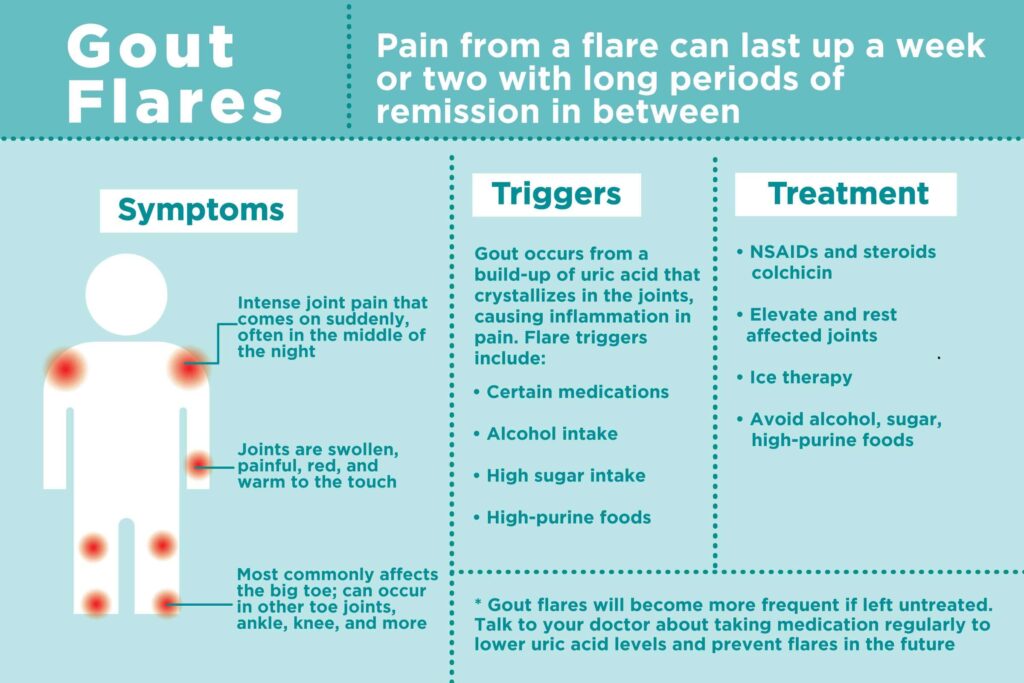
Most cases of gout can be controlled with oral medications. In some cases, gout sufferers can feel relief within days or even hours of beginning medication. However, those with frequent attacks may need long-term medications. In addition, repeated gout attacks can result in arthritic changes in the joints.
The joints of the feet are the most commonly affected by gout. While the big toe is the most common joint affected by the disease, it can also affect other joints, including the ankle, the instep, the knee, the wrist, and the elbow. It rarely affects the spine.
In some cases, it may be caused by overproduction of uric acid or by problems filtering the uric acid out of the blood. In these cases, the kidneys are not able to filter it out properly. The problem can also be caused by certain foods, certain medicines, and lifestyle factors.
If you have symptoms of arthritis, it is important to talk to your GP. He or she can recommend appropriate treatment for you. It’s also helpful to find out about your family history and other medical conditions.
Gout is a debilitating disease that can interfere with your life. It can affect your sleep and your mood. During a painful attack, it can make you feel very depressed and anxious. However, you can combat this by practicing mindfulness meditation and deep breathing techniques.
In addition, writing down your feelings and emotions can help you process your feelings. Also, getting a lot of exercise is an effective way to boost your feel-good hormones.
What Causes Gout?
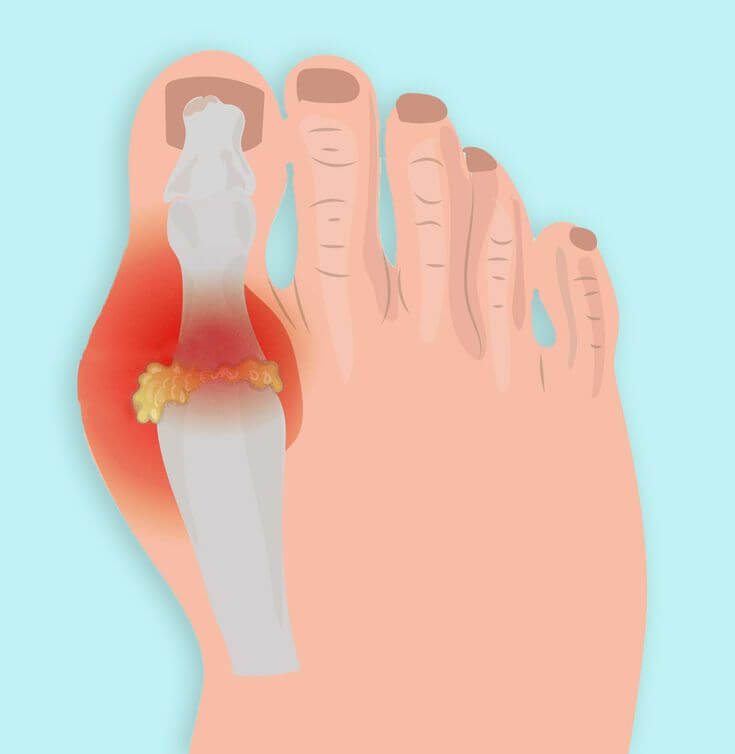
Gout can be a painful condition. It is caused by an overproduction of uric acid in the body. Keeping uric acid levels in check is the key to preventing flare-ups. You can reduce uric acid levels by limiting red meat and other foods that contain purines.
People with a family history of gout have a higher risk for developing gout. People with certain medical conditions such as diabetes, obesity, and high blood pressure are also at increased risk.
Also, recent surgery can increase the risk of gout. Lifestyle choices also play an important role in preventing or managing it. A diet heavy in meat and seafood, drinking a lot of alcohol, and consuming sugary beverages can all raise uric acid levels and contribute to gout.
People with certain blood disorders or cancer may also have elevated levels of uric acid. People with hyperuricemia may not have any symptoms of gout, but it increases their risk of developing crystals in the joints.
A doctor may perform blood tests to check uric acid levels, or take an x-ray to assess the level of damage in the affected joint.
The body produces uric acid when it breaks down certain substances called purines. These compounds are found in many foods, including red meat, seafood, and organ meats.
When excess uric acid accumulates in the blood, it forms crystals in the joint, resulting in inflammation and intense pain. In severe cases, these crystals can form visible lumps.
How Do We Test For Gout?
The first step in diagnosing gout is to collect a sample of joint fluid for a uric acid test. A non-rheumatologist can perform this test by putting a small needle into the joint and collecting a sample of fluid for examination under a microscope. If the fluid contains uric acid crystals, the uric acid test will show this.
A second step in diagnosing gout is to have an X-ray of the joint. A doctor will look for erosions and cysts in the joint, which are hallmarks of gout. The X-ray will also reveal collections of uric acid in various places.
In addition, the doctor will ask the patient about any kidney stones that they have had. If they have both, a rapid and aggressive uric acid lowering treatment will be needed.
Another way to diagnose it is by taking a sample of synovial fluid. This is a liquid that lines the joints and lubricates the space between the bones. This test is known as synovial fluid analysis, and is the gold standard for diagnosing gout. The healthcare provider will first use a local anesthetic to numb the area.
After that, they will insert a needle into the joint to collect a sample of synovial fluid. The sample is then sent to a lab for analysis. The healthcare provider may also look at the sample under a microscope to determine if there are any bacteria.
Many people with these flare-ups do not have a diagnosis at the first time they have symptoms. Others develop symptoms only after experiencing a major attack. In these cases, it is important to have a diagnosis so that treatment can begin as soon as possible.
The symptoms of gout include pain, swelling, and tenderness of the peripheral joint or bursa. These symptoms are known as symptomatic episodes.
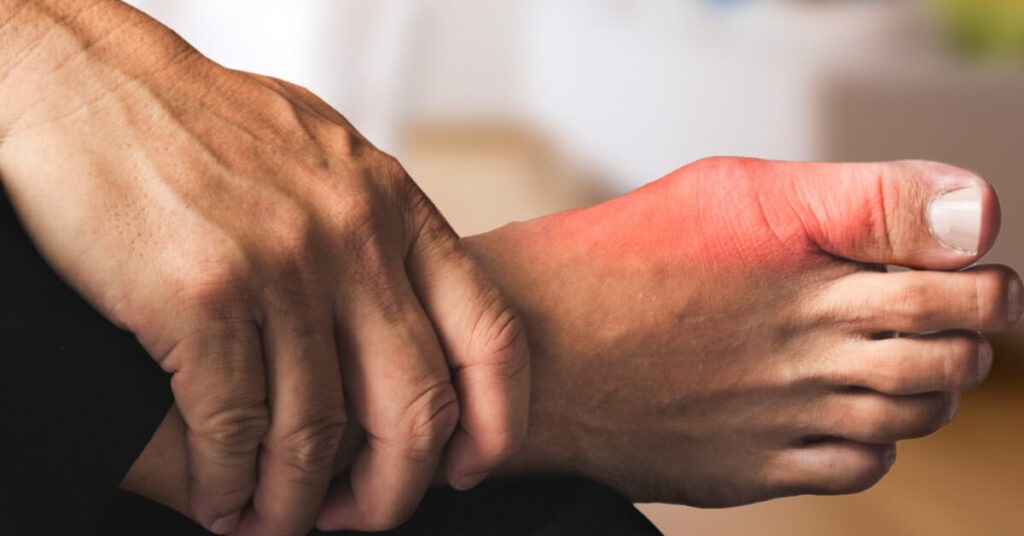
Gout Treatment Options
A physician may recommend one or more of several treatment options if you have a gout attack. Symptoms of this rich man’s disease include redness, swelling, stiffness, and intense pain.
These symptoms usually develop in the big toe, ankles, or heels. However, they can also occur in the fingers, elbows, or wrists.
Corticosteroids have been shown to be effective for acute gout attacks. These medications may be injected directly into the affected joint.
However, they may have gastrointestinal side effects and may not be suitable for every patient. Surgical intervention for gout is rare but is often recommended in some cases.
Surgical treatment is usually necessary when medications and lifestyle modifications are not sufficient to relieve the symptoms.
Advanced cases of gout, or chronic tophaceous gout, may require the removal of the painful and swollen tophi. While the procedure may be painful, it can often eliminate the underlying cause of gout and restore joint function.
A Mediterranean diet, rich in vegetables, nuts, and plant-based proteins, has been shown to decrease the risk of gout. It is also helpful in lowering the risk of metabolic syndrome. However, it is important to avoid foods high in purines.
This will ensure that the medication you take will be more effective and prevent flare-ups. If these methods don’t work, stronger prescription medications may be recommended. Occasionally, a patient may require corticosteroid medication to control inflammation and relieve pain.
Some treatments for gout include prescription medications that reduce uric acid production, reduce inflammation, and provide relief from pain and swelling. These medications can be taken orally, or by injection. Other nonprescription treatments include ice, rest, and elevation of the affected joint.
A Gout Diet to Get Rid of Gout
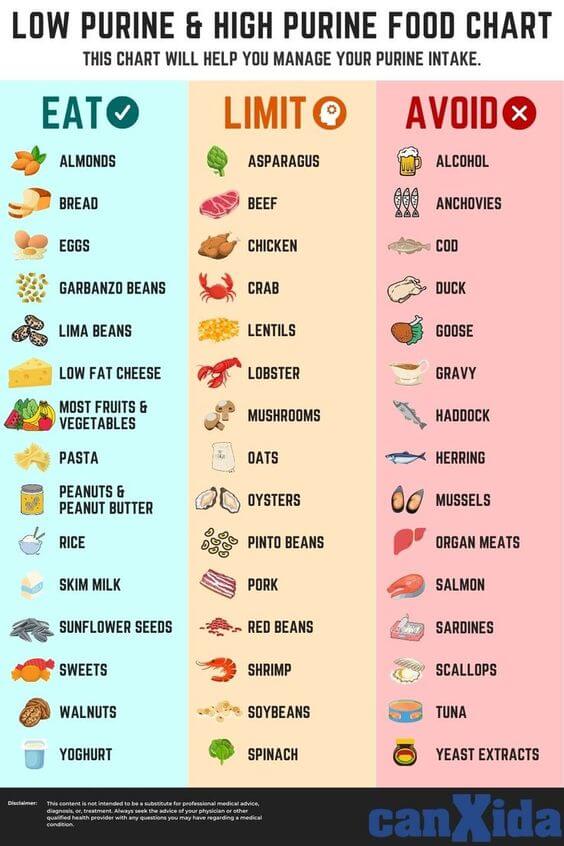
A Gout Diet aims to help you get rid of your gout by restricting foods high in purines. These are found in many foods, such as organ meats and processed meats. Moreover, these foods can increase the amount of uric acid in the body.
The Gout Education Society recommends limiting intake of these foods and limiting the number of processed food items, including fast food restaurants.
You can also try cutting down on seafood because it may worsen gout symptoms. Though many types of fish have higher purine levels, there are also oily fish, which contain lower purine levels. In moderation, oily fish is considered healthy.
Furthermore, a diet rich in vegetables can help you maintain a healthy weight and provide the body with essential vitamins and minerals.
People with gout should include at least five servings of fruits and vegetables. This is important because a diet high in fruit and vegetables can help lower the amount of uric acid in the blood. It is also important to drink plenty of water, since this will help flush out excess uric acid in the body.
In addition to fruits and vegetables, you should also include moderate amounts of lean meat. You can also choose chicken, turkey, and other seafood. They are low in purine content compared to other types of meat.
Moreover, eggs, plain yogurt, and soy products are good choices for your diet. You should also avoid sugary foods, which are high in purines.
Gout Medication
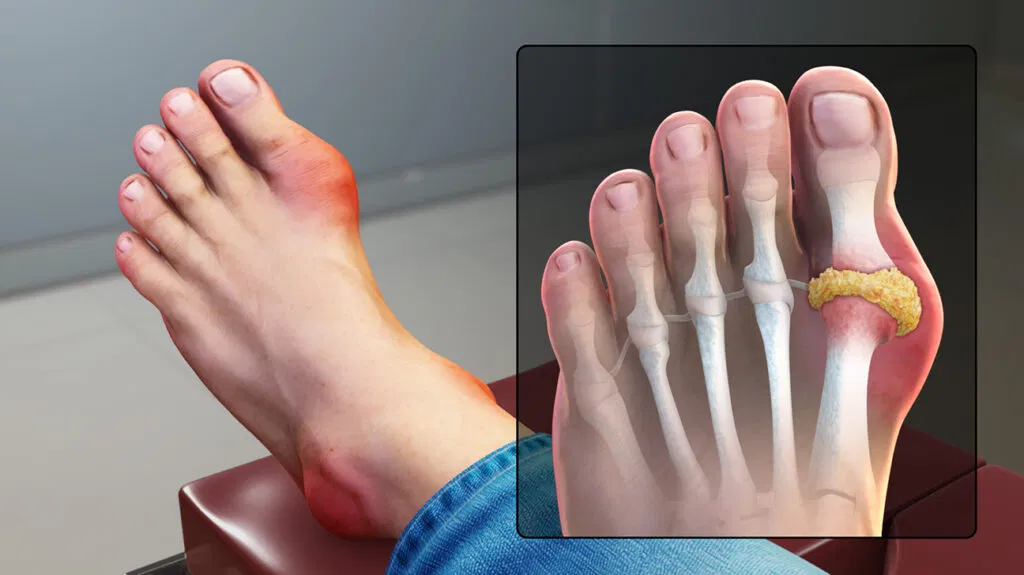
Gout medication is available in many forms and is highly effective for the vast majority of people suffering from gout. Despite this, some individuals do not respond well to these medications, or they may find that they are not effective enough.
Because of this, new and improved treatments are being sought to help those with gout. Some of these new treatments include arhalofenate, anakinra, and rilonacept.
The first step in treating gout is to prevent an attack from starting. If you do not take medication as soon as you notice an attack, you risk the symptoms worsening.
Using ice packs, ice bags, and elevating the affected leg may help reduce symptoms. However, it is important to remember that these treatments do not eliminate the underlying condition.
Colchicine is a prescription medication that reduces pain in people with acute gout attacks. It can also be taken in low doses to prevent attacks.
As described by WebMD, Colchicine reduces swelling and the build-up of uric acid crystals, which cause pain in affected joints. However, it is important to note that colchicine can interact with certain medications, such as statins and NSAIDs.
People with kidney problems should also avoid taking colchicine. It can also lead to stomach aches and diarrhoea. In addition, steroids can be used to treat acute attacks of gout.
Some patients may also be prescribed biologics, such as anakinra. This type of medication is designed to block an inflammatory protein called IL-1, which plays a major role in gouty inflammation.
This medication is injected into the affected area once daily, and it can be continued indefinitely if needed. However, it is very expensive and is not FDA-approved for treating Gouty arthritis alone.
Gout Prevention – How to Reduce Your Risk of Getting Gout
There are many ways to treat Gouty arthritis and prevent future flare-ups, but one of the most effective and simple is to reduce your risk of getting it.
Gouty arthritis attacks tend to come on suddenly and may affect the joints in your ankles, knees, elbows, wrists, and fingers. In addition, gout can cause painful fever and muscle aches. To reduce the pain, you should rest and elevate the affected joint.
The first step is to see a doctor for a diagnosis. The doctor will perform various tests, including uric acid testing. Other tests can include pulling fluid from the affected area, ultrasound images, and X-rays. Self-treatments for gout are also possible, including using warm compresses on the joint and elevating it as much as possible.
Changing your diet is also critical to gout prevention. A plant-based diet has been shown to reduce the incidence of gout attacks. Increasing omega-3 fatty acids is linked with a decreased risk of gout flare-ups.
Additionally, it’s important to cut your intake of sugary beverages. Cutting your added sugar intake will help your body flush out uric acid in the urine. Increasing your water consumption can also make your urine lighter and less odorous.
Another method of gout prevention is to reduce the amount of uric acid in the blood. The presence of high levels of uric acid in the blood is known as hyperuricemia. Many people with this condition go years without experiencing gout symptoms.
However, people who have this condition are often encouraged to make lifestyle changes to lower the amount of uric acid in the blood.
Making the diagnosis of Gout
There are some key signs to look for in an acute gouty arthritis patient, and a thorough diagnosis is crucial. Symptoms of gout include intense swelling and pain in one joint. The most common afflictions are in the big toe and the foot, but it can affect any joint.
Treatment involves avoiding triggers and taking medicines that can help relieve symptoms. The most effective gout treatment is tailored to the individual patient.
Depending on the severity of the symptoms, kidney function, and other health conditions, patients may require various medicines. Some of these medicines can reduce uric acid levels.
While gout can be caused by various diseases and medications, the first symptoms typically appear in the middle ages. About 3 percent of the population is affected by gout. Most people develop their first attack in their mid-40s. Patients with gout tend to have an attack in their big toe.
Although it is not a life threatening condition, it is still a painful and disabling condition. The disease is a chronic inflammatory disease that can be difficult to treat and can have long-lasting effects on the involved joint.
Symptoms of gout include redness, inflammation, and general discomfort. Usually, the first episode of symptoms will last three to ten days. If treatment begins quickly, the disease is often easier to treat.
Gout and Women
Gout in women can be treated the same way as in men, with the use of NSAIDs and uricosurics. These drugs can help reduce the frequency of attacks and increase excretion.
However, they can be dangerous and can cause serious side effects. Common NSAIDs include colchicine and allopurinol.
Women are at greater risk for gout than men. Menopause, which occurs after women reach age 51, is believed to increase uric acid levels in the blood. Alcohol and diuretics are also common risk factors for gout in women.
Alcohol consumption, high blood pressure, and total meat intake were also associated with gout risk.
Despite its low incidence, women are still at a higher risk of gout than men. Women who have a family history of the disease are at an increased risk of developing it.
While there are several risk factors for women, early diagnosis and treatment is key to preventing complications and living a pain-free life.
Fructose-rich beverages have also been linked to higher levels of uric acid in the blood. This may contribute to the risk of gout, although prospective studies are limited.
Gout statistics and facts
- A study by the Hospital for Special Surgery found that 8.3 million people in the United States suffer from gout (6.1 million men and 2.2 million women).
- Among people who have gout attacks, 90% have kidneys that don’t remove enough uric acid from their urine while 10% make too much uric acid in their system.
- 90% of gout attacks start in a single joint. Most often, it is the “bunion joint” of the big toe.
- 90% of gout patients have one or more of the following conditions (comorbidities), which make it more difficult to manage gout: kidney dysfunction, coronary heart disease, obesity, high cholesterol and/or triglycerides, diabetes mellitus.
Editor’s Note: We would appreciate it if you could let us know if any of our content is inaccurate or outdated at press@nowthendigital.com.
You’re reading nowthendigital.com — which breaks the news about Uganda, Kenya, Nigeria, South Africa and the rest of the world, day after day. Be sure to check out our homepage for all the latest news, and follow NOW THEN DIGITAL on YouTube, Google, Web Stories, Google News, Medium, Twitter, Reddit, Pinterest, Linktr, Buy Me a Coffee, and Flipboard to stay in the loop.


